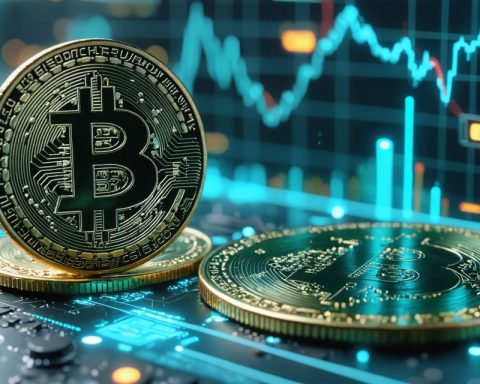Significant changes are on the horizon for the world of digital assets. In a recent executive order, the government is taking decisive steps to shape how digital currencies and assets are managed and regulated.
The order instructs federal agencies to develop a comprehensive regulatory framework, aimed at establishing guidelines for digital asset management. This initiative underscores a growing recognition of the importance and influence of cryptocurrencies and other digital financial products in today’s economy.
In an intriguing twist, the government is also considering the establishment of a digital asset stockpile. This move could redefine how assets are stored and safeguarded, signaling a strategic pivot in how digital currencies are integrated into the financial system.
As digital currencies gain traction among investors and the public, the creation of a regulatory framework is essential. This ensures that the growth and proliferation of digital assets occur in a safe and structured manner.
With these steps, the government aims to position itself at the forefront of the digital asset revolution. As they work on this new framework, the potential implications for the economy and financial markets are vast. Stakeholders from various sectors will be closely watching these developments, as they may set the stage for the next generation of digital finance.
Embracing the Digital Asset Revolution
The recent executive order regarding digital assets signifies much more than just regulatory oversight; it marks a pivotal moment for the global economy as it grapples with the complexities of integrating cryptocurrencies into mainstream finance. The recognition of digital currencies as significant financial instruments is reshaping traditional economic paradigms, forcing societies to rethink how value is created, stored, and exchanged.
Moreover, the potential establishment of a federal digital asset stockpile raises pertinent questions about trust, security, and the future of monetary policy. This move could serve as an anchor in times of financial volatility, potentially stabilizing digital assets and their wild price fluctuations. If successful, it would enhance confidence among investors and consumers, reinforcing the legitimacy of cryptocurrencies in everyday transactions.
On the environmental front, the rise of digital assets is also a topic of considerable debate. Cryptocurrency mining’s substantial energy consumption has already sparked discussions about sustainability. As regulatory frameworks evolve, there is an opportunity to mandate greener practices within the digital asset space, pushing for innovations that prioritize renewable energy sources.
Looking ahead, the implications of these developments could extend well into the future. With digital currencies expected to integrate further into global markets, the rise of central bank digital currencies (CBDCs) may redefine economic sovereignty, allowing nations to maintain control over their monetary systems while embracing innovation. As such, societies must remain vigilant, balancing the promise of new technologies with the need for sustainable and equitable financial solutions.
Transforming the Future: How New Regulations Will Impact Digital Assets
Introduction
The landscape of digital assets is on the verge of a transformative shift. Recent actions from the government signal a pivotal change in how cryptocurrencies and other digital financial products are managed, regulated, and integrated into the broader financial system. This article delves into the implications of these forthcoming regulations, their potential effects on various stakeholders, and the overall market dynamics they may create.
New Regulatory Framework
The executive order issued by the government mandates federal agencies to develop a comprehensive regulatory framework for digital assets. This framework is expected to address several key areas, including:
– Consumer Protection: Establishing guidelines that protect investors and consumers from scams and fraud prevalent in the crypto space.
– Market Integrity: Ensuring that trading and investment in digital assets occur in a fair and transparent manner.
– Compliance Standards: Setting forth compliance metrics that businesses dealing with digital currencies must follow, thereby enhancing accountability.
Potential for a Digital Asset Stockpile
In a noteworthy development, the government is contemplating the establishment of a digital asset stockpile. This stockpile could serve multiple purposes:
– Secured Storage: Providing a secure method of safeguarding digital assets against theft or loss.
– Liquidity Management: Enabling authorities to manage liquidity within the market more effectively by having immediate access to digital currencies.
– Crisis Mitigation: Offering a mechanism to stabilize the market in times of financial turbulence, potentially reducing volatility driven by speculative trading.
Economic and Market Implications
The creation of a structured regulatory environment for digital assets is crucial as their adoption continues to rise. Here are some potential implications:
– Increased Investment: With clear regulations in place, institutional and retail investors may feel more confident investing in digital currencies, leading to increased market capitalization.
– Innovation Stimulation: A well-defined regulatory framework can foster innovation by offering clarity to companies working on digital asset technologies.
– Global Competitiveness: As countries around the world race to establish their crypto regulations, the U.S. could solidify its position as a leader in the digital finance sector.
Use Cases of Digital Assets
Digital assets are versatile and can be employed in various sectors. Some prevalent use cases include:
– Remittances: Facilitating cross-border transactions with lower fees compared to traditional banking systems.
– Decentralized Finance (DeFi): Allowing users to lend, borrow, and trade without intermediaries, which can lead to higher returns on investments.
– Smart Contracts: Automating agreements and transactions without the need for third-party enforcement, saving time and cost.
Limitations and Challenges
While the prospects for digital assets are promising, there are limitations and challenges to be addressed:
– Regulatory Overhead: Increased compliance requirements may deter smaller businesses from entering the market.
– Technological Barriers: The complexity of blockchain technology may pose a barrier to entry for many potential users and investors.
– Market Fluctuations: Ongoing volatility in digital asset prices can undermine confidence and hinder widespread adoption.
Future Predictions
The future of digital assets is poised for significant changes. Key predictions include:
– Increased Regulatory Scrutiny: As the market matures, expect more robust regulations aimed at curbing illegal activities.
– Integration with Traditional Finance: We may see the convergence of traditional financial systems with digital assets, offering consumers more options.
– Emergence of Central Bank Digital Currencies (CBDCs): Governments may launch their own digital currencies to enhance control over monetary policy and foster financial inclusion.
Conclusion
As the government takes steps to regulate digital assets, the ramifications for the economy and financial markets are significant. Stakeholders across various sectors must remain vigilant to adapt to these changes. With a focus on safety, transparency, and innovation, the future of digital finance is not just bright—it’s transformational.
For further insights on digital assets and regulatory developments, visit CoinDesk.









